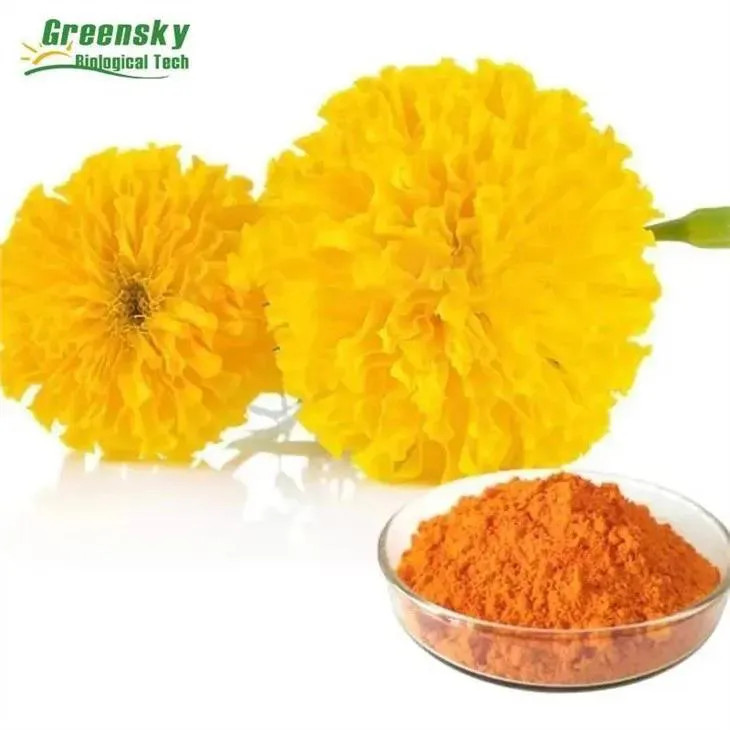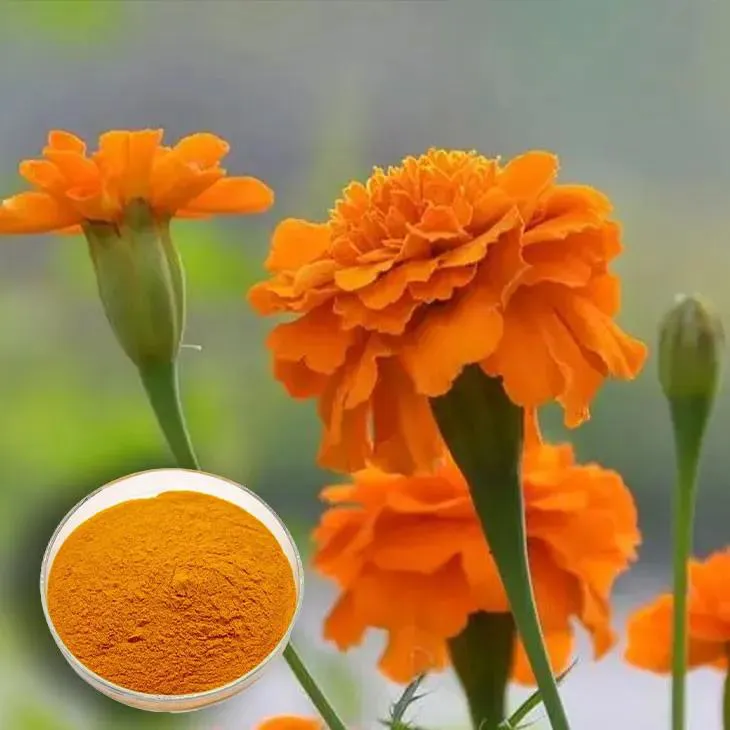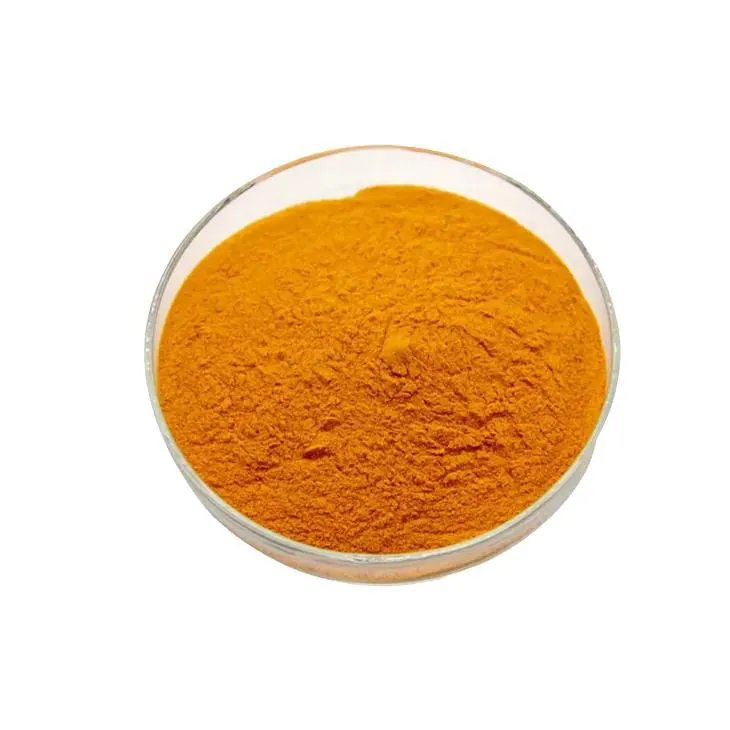- 0086-571-85302990
- sales@greenskybio.com
High - quality Marigold Extract Products.
2024-11-27

1. Origin and Quality
High - quality Marigold Extract products are sourced from premium marigold varieties. These marigolds are
cultivated under optimal conditions to ensure the highest quality. During the growth process, the plants are
closely monitored to prevent diseases and pests, which could otherwise have a negative impact on the quality
of the extract.
The choice of marigold variety is crucial. Only those varieties with high content of active ingredients are
selected for cultivation. For example, certain marigold varieties are known for their rich concentration of
lutein and zeaxanthin, which are the key components in Marigold Extract with numerous health benefits.
The cultivation environment also plays a vital role. Adequate sunlight, water, and soil quality are essential
factors. Marigolds thrive in well - drained soil with a proper balance of nutrients. In addition, the use of
organic fertilizers can enhance the quality of the plants. This not only benefits the growth of marigolds but
also ensures that the extract obtained is free from harmful chemical residues.

2. Scientifically - Backed Benefits
There is a growing body of scientific research supporting the benefits of Marigold Extract.
2.1 Eye Health
In terms of eye health, the lutein and zeaxanthin in the extract are deposited in the macula of the eye,
protecting it from damage caused by free radicals. This is especially important in an age where digital device
usage is high and eye strain is a common problem.
Free radicals are highly reactive molecules that can cause oxidative stress in the body, particularly in the
eyes. The macula, which is responsible for central vision, is highly susceptible to such damage. Lutein and
zeaxanthin act as antioxidants, neutralizing free radicals and reducing the risk of age - related macular
degeneration (AMD), a leading cause of vision loss in the elderly.
Moreover, these carotenoids can also improve visual acuity and contrast sensitivity. Studies have shown that
individuals with higher levels of lutein and zeaxanthin in their diet or through supplementation tend to have
better vision performance.
2.2 Antioxidant Properties
Marigold extract also exhibits strong antioxidant properties. Antioxidants are substances that can prevent or
slow down the damage to cells caused by free radicals. Besides lutein and zeaxanthin, other components in the
extract may also contribute to its antioxidant activity.
These antioxidant properties are beneficial for overall health. They can help in reducing the risk of chronic
diseases such as heart disease, cancer, and neurodegenerative disorders. By neutralizing free radicals in the
body, marigold extract can play a role in maintaining the integrity of cells and tissues.

3. Manufacturing Excellence
The manufacturing process of high - quality marigold extract is a complex yet well - regulated procedure.
3.1 Harvesting
From the initial harvesting of marigolds to the final packaging of the extract, every step is carefully
monitored. The timing of harvesting is crucial. Marigolds are usually harvested when they reach their peak
maturity, which is when the content of active ingredients is at its highest.
During harvesting, proper handling techniques are employed to avoid damage to the plants. Only healthy and
fully - grown marigolds are selected for further processing. This ensures that the raw material used for
extraction is of the highest quality.
3.2 Extraction Process
The extraction process itself is a key step in obtaining high - quality marigold extract. There are various
extraction methods available, such as solvent extraction and supercritical fluid extraction.
Solvent extraction is a commonly used method. However, the choice of solvent is critical. Organic solvents like
hexane or ethanol are often used, but strict regulations are in place to ensure that any residual solvent in
the final product is within safe limits. Supercritical fluid extraction, on the other hand, is a more advanced
technique that uses supercritical carbon dioxide as the solvent. This method has the advantage of being more
environmentally friendly and can produce a purer extract.
During extraction, accurate dosing is essential. This ensures that the final product has a consistent
concentration of active ingredients. Quality control measures are implemented at every stage of the extraction
process to monitor the quality and purity of the extract.
3.3 Packaging
Good Manufacturing Practice (GMP) is often followed to ensure consistency and quality. This includes proper
handling of raw materials, accurate dosing during extraction, and sterile packaging.
The packaging material used for marigold extract products should be able to protect the product from light,
moisture, and air. Dark - colored glass bottles or opaque plastic containers are often preferred as they can
prevent the degradation of the active ingredients due to exposure to light. Additionally, proper sealing is
necessary to prevent air and moisture from entering the package, which could lead to spoilage or a decrease in
the effectiveness of the extract.

4. Market Potential
In the market, high - quality marigold extract products have a broad range of potential applications.
4.1 Supplement Market
In the supplement market, it is sold as a stand - alone product for those seeking eye health support or general
antioxidant benefits. Many consumers are becoming more health - conscious and are looking for natural products
to improve their well - being. Marigold extract supplements are an attractive option as they are derived from a
natural source and have been scientifically proven to have certain health benefits.
These supplements are available in various forms, such as capsules, tablets, and softgels. They are often
marketed with clear labeling indicating the content of lutein and zeaxanthin, as well as other relevant
information about the product.
4.2 Pharmaceutical Industry
In the pharmaceutical industry, it may be further developed into drugs targeting specific eye diseases in the
future. The potential of marigold extract in treating or preventing eye diseases such as AMD has attracted the
attention of pharmaceutical researchers.
With further research and development, it is possible that marigold extract - based drugs could be developed
with enhanced efficacy and fewer side effects compared to existing treatments. However, this requires more
in - depth scientific studies and clinical trials to validate its safety and effectiveness as a pharmaceutical
product.
4.3 Beauty and Personal Care Market
In the beauty and personal care market, marigold extract - based products are popular for their skin - nourishing
and anti - inflammatory effects.
Marigold extract contains compounds that can moisturize the skin, improve skin elasticity, and reduce the
appearance of fine lines and wrinkles. It is often used in skincare products such as creams, lotions, and
serums.
Additionally, its anti - inflammatory properties make it suitable for treating skin conditions such as acne,
eczema, and psoriasis. It can soothe irritated skin and reduce redness and swelling.

5. Environmental and Sustainability Considerations
The production of high - quality marigold extract also takes into account environmental and sustainability factors.
5.1 Sustainable Farming Practices
Marigold cultivation can be part of sustainable farming practices, such as crop rotation. Crop rotation helps in
maintaining soil fertility by alternating different crops in the same field over time.
For example, marigolds can be rotated with other crops like legumes. Legumes have the ability to fix nitrogen in
the soil, which can benefit the growth of marigolds in the subsequent season. This also reduces the need for
synthetic fertilizers, which are often energy - intensive to produce and can have negative environmental
impacts.
In addition, sustainable marigold farming may also involve the use of natural pest control methods. Instead of
relying solely on chemical pesticides, farmers can use beneficial insects or plant - based repellents to
control pests. This not only protects the environment but also ensures that the marigold extract obtained is
free from pesticide residues.
5.2 Minimizing Waste and Energy Consumption
The extraction process can be designed to minimize waste and energy consumption. For example, in solvent
extraction, the solvents can be recycled and reused, reducing the amount of waste generated.
In the case of supercritical fluid extraction, although it requires more complex equipment, it generally has
lower energy consumption compared to traditional extraction methods in the long run. This is because it can be
more efficient in extracting the active ingredients with less solvent usage.
Moreover, waste materials from the marigold plants, such as the stems and leaves, can be further processed or
composted. Composting these waste materials can produce organic fertilizers that can be used in marigold
cultivation or other farming activities, closing the loop of resource utilization.
In conclusion, high - quality marigold extract products are not only beneficial in terms of health and commercial applications but also in line with environmental and sustainability goals. As research continues to uncover more about the properties and potential of marigold extract, its importance in multiple industries is likely to increase.
FAQ:
What are the main sources of high - quality marigold extract products?
High - quality marigold extract products are sourced from premium marigold varieties. These marigolds are cultivated under optimal conditions.
What are the scientifically - proven benefits of marigold extract?
There is a growing body of scientific research. In terms of eye health, the lutein and zeaxanthin in the extract are deposited in the macula of the eye, protecting it from damage caused by free radicals. This is important considering high digital device usage and common eye strain.
How is the manufacturing process of high - quality marigold extract?
The manufacturing process is complex yet well - regulated. From harvesting to final packaging, every step is carefully monitored. Good Manufacturing Practice (GMP) is often followed, including proper raw material handling, accurate dosing during extraction, and sterile packaging.
What are the market applications of high - quality marigold extract products?
In the supplement market, it is sold as a stand - alone product for eye health support or antioxidant benefits. In the pharmaceutical industry, it may be developed into drugs for specific eye diseases in the future. In the beauty and personal care market, marigold - extract - based products are popular for skin - nourishing and anti - inflammatory effects.
How does the production of high - quality marigold extract consider environmental and sustainability factors?
Marigold cultivation can be part of sustainable farming practices like crop rotation. The extraction process can be designed to minimize waste and energy consumption.
Related literature
- The Health Benefits of Marigold Extract: A Comprehensive Review"
- "Marigold Extract in Pharmaceutical Research: Current and Future Prospects"
- "Sustainable Production of Marigold Extract: Environmental Considerations"
- ▶ Hesperidin
- ▶ Citrus Bioflavonoids
- ▶ Plant Extract
- ▶ lycopene
- ▶ Diosmin
- ▶ Grape seed extract
- ▶ Sea buckthorn Juice Powder
- ▶ Fruit Juice Powder
- ▶ Hops Extract
- ▶ Artichoke Extract
- ▶ Mushroom extract
- ▶ Astaxanthin
- ▶ Green Tea Extract
- ▶ Curcumin
- ▶ Horse Chestnut Extract
- ▶ Other Product
- ▶ Boswellia Serrata Extract
- ▶ Resveratrol
- ▶ Marigold Extract
- ▶ Grape Leaf Extract
- ▶ New Product
- ▶ Aminolevulinic acid
- ▶ Cranberry Extract
- ▶ Red Yeast Rice
- ▶ Red Wine Extract
-
Sugarcane Extract
2024-11-27
-
Longan Extract
2024-11-27
-
Centella Asiatica Extract
2024-11-27
-
Nettle leaf extract
2024-11-27
-
Sea buckthorn Juice Powder
2024-11-27
-
Grapefruit Seed Extract Powder
2024-11-27
-
Artichoke Extract
2024-11-27
-
Mango flavored powder
2024-11-27
-
Acai Berry Extract
2024-11-27
-
Peppermint Oil
2024-11-27





















